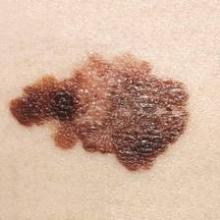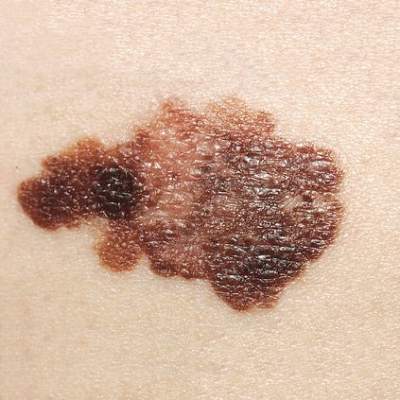User login
For patients with resected stage III melanoma, intermittent intravenous high-dose IFN–alpha-2b (iHDI) is not superior to conventional 1-year high-dose IFN–alpha-2b therapy, according to results from a phase III study. Relapse-free survival was significantly inferior with the intermittent regimen.
“These data preclude speculation about a possible equivalence of the regimens. Taken together, the approved schedules for adjuvant IFN [interferon] treatment of patients with melanoma are likely to remain the standard of care until new approaches, such as with ipilimumab or other drugs, show durable improvements in RFS or OS and acceptable safety profiles,” wrote Dr. Peter Mohr of Elbe-Klinikum Buxtehude, Germany, and his colleagues (J Clin. Onc. 2015 Oct. 26. doi: 10.1200/JCO.2015.59.6932).
The prospective, multicenter, phase III randomized trial included 649 patients with stage III melanoma who received either three courses of iHDI or the conventional HDI 1-year regimen.After a median follow-up time of 55 months, distant metastasis-free survival and overall survival for the two treatment schedules were similar. The 5-year distant metastasis-free survival for iHDI, compared with HDI, was 49.2% vs. 53.1%; 5-year overall survival was 62.9% vs. 64.1%, respectively. However, relapse-free survival was significantly worse for iHDI than for HDI (hazard ratio, 1.27; 95% confidence interval, 1.02-1.59; P = .03).
Adverse events (AEs) were similar for the two arms, except the HDI group experienced more anemia than the iHDI group (48.1% vs. 30.9%; P less than .001) and neutropenia of grade 3 or higher was more frequent in the iHDI group (38.9% vs. 30.1%; P = .004). The intermittent schedule resulted in fewer cumulative AEs, particularly grade 3 or 4 fatigue. Fatigue is an expected but often debilitating AE of HDI therapy, the investigators noted.
Reduced fatigue was associated with 40% less early discontinuation with iHDI than with standard HDI. In the iHDI group, quality of life measures returned to or exceeded baseline values within 4 weeks of administration. However, improvements in quality of life should be weighed against potential loss of efficacy: at least 50% of patients would tolerate moderate or severe IFN–alpha-2b toxicity for improvement in 5-year, disease-free survival, the investigators said.
For patients with resected stage III melanoma, intermittent intravenous high-dose IFN–alpha-2b (iHDI) is not superior to conventional 1-year high-dose IFN–alpha-2b therapy, according to results from a phase III study. Relapse-free survival was significantly inferior with the intermittent regimen.
“These data preclude speculation about a possible equivalence of the regimens. Taken together, the approved schedules for adjuvant IFN [interferon] treatment of patients with melanoma are likely to remain the standard of care until new approaches, such as with ipilimumab or other drugs, show durable improvements in RFS or OS and acceptable safety profiles,” wrote Dr. Peter Mohr of Elbe-Klinikum Buxtehude, Germany, and his colleagues (J Clin. Onc. 2015 Oct. 26. doi: 10.1200/JCO.2015.59.6932).
The prospective, multicenter, phase III randomized trial included 649 patients with stage III melanoma who received either three courses of iHDI or the conventional HDI 1-year regimen.After a median follow-up time of 55 months, distant metastasis-free survival and overall survival for the two treatment schedules were similar. The 5-year distant metastasis-free survival for iHDI, compared with HDI, was 49.2% vs. 53.1%; 5-year overall survival was 62.9% vs. 64.1%, respectively. However, relapse-free survival was significantly worse for iHDI than for HDI (hazard ratio, 1.27; 95% confidence interval, 1.02-1.59; P = .03).
Adverse events (AEs) were similar for the two arms, except the HDI group experienced more anemia than the iHDI group (48.1% vs. 30.9%; P less than .001) and neutropenia of grade 3 or higher was more frequent in the iHDI group (38.9% vs. 30.1%; P = .004). The intermittent schedule resulted in fewer cumulative AEs, particularly grade 3 or 4 fatigue. Fatigue is an expected but often debilitating AE of HDI therapy, the investigators noted.
Reduced fatigue was associated with 40% less early discontinuation with iHDI than with standard HDI. In the iHDI group, quality of life measures returned to or exceeded baseline values within 4 weeks of administration. However, improvements in quality of life should be weighed against potential loss of efficacy: at least 50% of patients would tolerate moderate or severe IFN–alpha-2b toxicity for improvement in 5-year, disease-free survival, the investigators said.
For patients with resected stage III melanoma, intermittent intravenous high-dose IFN–alpha-2b (iHDI) is not superior to conventional 1-year high-dose IFN–alpha-2b therapy, according to results from a phase III study. Relapse-free survival was significantly inferior with the intermittent regimen.
“These data preclude speculation about a possible equivalence of the regimens. Taken together, the approved schedules for adjuvant IFN [interferon] treatment of patients with melanoma are likely to remain the standard of care until new approaches, such as with ipilimumab or other drugs, show durable improvements in RFS or OS and acceptable safety profiles,” wrote Dr. Peter Mohr of Elbe-Klinikum Buxtehude, Germany, and his colleagues (J Clin. Onc. 2015 Oct. 26. doi: 10.1200/JCO.2015.59.6932).
The prospective, multicenter, phase III randomized trial included 649 patients with stage III melanoma who received either three courses of iHDI or the conventional HDI 1-year regimen.After a median follow-up time of 55 months, distant metastasis-free survival and overall survival for the two treatment schedules were similar. The 5-year distant metastasis-free survival for iHDI, compared with HDI, was 49.2% vs. 53.1%; 5-year overall survival was 62.9% vs. 64.1%, respectively. However, relapse-free survival was significantly worse for iHDI than for HDI (hazard ratio, 1.27; 95% confidence interval, 1.02-1.59; P = .03).
Adverse events (AEs) were similar for the two arms, except the HDI group experienced more anemia than the iHDI group (48.1% vs. 30.9%; P less than .001) and neutropenia of grade 3 or higher was more frequent in the iHDI group (38.9% vs. 30.1%; P = .004). The intermittent schedule resulted in fewer cumulative AEs, particularly grade 3 or 4 fatigue. Fatigue is an expected but often debilitating AE of HDI therapy, the investigators noted.
Reduced fatigue was associated with 40% less early discontinuation with iHDI than with standard HDI. In the iHDI group, quality of life measures returned to or exceeded baseline values within 4 weeks of administration. However, improvements in quality of life should be weighed against potential loss of efficacy: at least 50% of patients would tolerate moderate or severe IFN–alpha-2b toxicity for improvement in 5-year, disease-free survival, the investigators said.
Key clinical point: Distant metastasis-free survival and overall survival were similar in patients with stage III melanoma treated with intermittent high-dose intravenous IFN–alpha-2b (iHDI) vs. standard 1-year high-dose IFN–alpha-2b (HDI), but the difference for relapse-free survival was significant (HR, 1.27; P = .03), favoring standard HDI.
Major finding: The 5-year distant metastasis-free survival for iHDI, compared with HDI was 49.2% vs. 53.1%; 5-year overall survival was 62.9% vs. 64.1%, respectively. Relapse-free survival was significantly worse for iHDI than HDI (HR, 1.27; 95% CI, 1.02-1.59; P = .03).
Data source: The prospective, multicenter, phase III trial randomized 649 patients with stage III melanoma to receive either three courses of iHDI or the conventional HDI 1-year regimen.
Disclosures: Dr. Mohr reported financial relationships with Merck, Bristol-Myers Squibb, Roche, GlaxoSmithKline, LEO Pharma, Novartis, Merck Sharp & Dohme, and Roche. Several of his coauthors reported having ties to industry sources.

